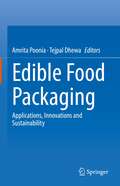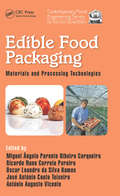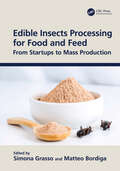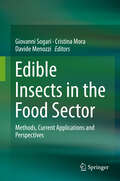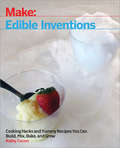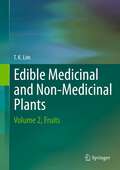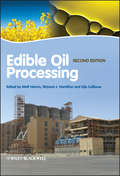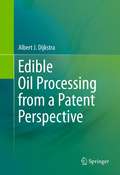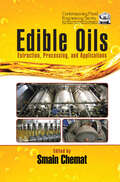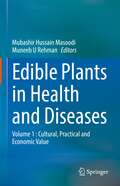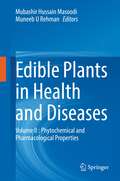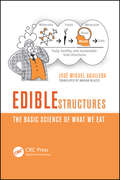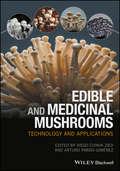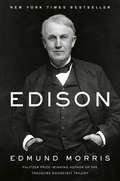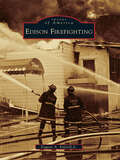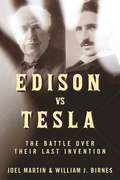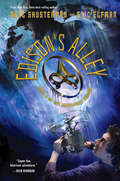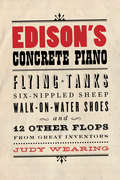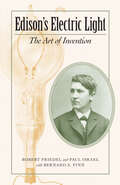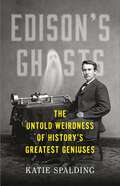- Table View
- List View
Edible Food Packaging: Applications, Innovations and Sustainability
by Amrita Poonia Tejpal DhewaThis book discusses the various aspects of sustainable packaging edibles in food industry. It is divided into five main parts. The first section of the book addresses details of edible films, various sources, origin, scope and functions. Second section covers different sustainable alternatives such as seed gums, fruits and vegetable peels, sea weeds, fruits wastes, dairy by products & anti-oxidant edible packaging. This book also discusses about methods of improvements of mechanical properties of packaging edibles & their food applications, testing methods, innovations, limitations, challenges and nano edibles. It provides insights about the large quantity of wastes and by-products generated by food processing industries. Disposal of these wastes is a big problem due to their high biochemical oxygen demand (BOD) & chemical oxygen demand (COD) which causes severe problem of pollution to the environment. These wastes contain large amounts of proteins, carbohydrates, lipids, minerals, various bioactive compounds and have eco-friendly packaging potential. The book emphasizes on the fact that recycling these wastes as packaging edibles are sustainable and economical. As a world foreseeing food technology revolution, this book explores the unique topics in food packaging which possesses mammoth commercial applications and environmental potential. Due to its immense scope, this book is highly useful for researchers, food scientists, students and food packaging industry experts.
Edible Food Packaging: Materials and Processing Technologies (Contemporary Food Engineering)
by Miquel Angelo Cerqueira Ricardo Nuno Pereira Oscar Leandro Ramos Jose Antonio Teixeira Antonio Augusto VicenteThe edible food packaging industry has experienced remarkable growth in recent years and will continue to impact the food market for quite some time going into the future. Edible Food Packaging: Materials and Processing Technologies provides a broad and comprehensive review on recent aspects related to edible packaging, from processing to potential applications, and covering the use of nanotechnology in edible packaging. The book’s 14 chapters promote a comprehensive review on such subjects as materials used, their structure-function relationship, and new processing technologies for application and production of edible coatings and films. Specific topics include edible film and packaging using gum polysaccharides, protein-based films and coatings, and edible coatings and films from lipids, waxes, and resins. The book also reviews stability and application concerns, mass transfer measurement and modeling for designing protective edible films, and edible packaging as a vehicle for functional compounds. The authors explore antimicrobial edible packaging, nanotechnology in edible packaging, and nanostructured multilayers for food packaging by electrohydrodynamic processing. Additionally, they show how to evaluate the needs for edible packaging of respiring products and provide an overview of edible packaging for fruits, vegetables, and dairy products. Lastly, they examine edible coatings and films for meat, poultry, and fish.
Edible Insects Processing for Food and Feed: From Startups to Mass Production
by Simona Grasso and Matteo BordigaConsumers around the world are becoming increasingly aware of the significant impacts of food consumption on the environment, and demand for more sustainable foods is expanding rapidly. Edible Insects Processing for Food and Feed: From Startups to Mass Production focuses on the growing topic of insects as food and feed, covering not only production elements, but also case studies and several other areas of interest, such as environmental aspects, nutritional value, consumers, food safety and market statistics. Key Features: Includes several case studies and latest advancements in the area Contains multidisciplinary approach, covering farm-to-fork aspects Contains full account of contemporary developments in mass production of edible insects Written by passionate leading academics and industry partners around the globe, this book aims to bring together the latest advancements in edible insect production in a dynamic, modern and multidisciplinary approach. It is a one-stop shop that will give readers a flavour of where the fascinating topic of edible insect production is now, but more importantly of where it might be heading to in the future, showcasing several related challenges and opportunities.
Edible Insects in the Food Sector: Methods, Current Applications and Perspectives
by Giovanni Sogari Cristina Mora Davide MenozziThis book explores one of the most discussed and investigated novel foods in recent years: edible insects. The increasing demand for alternative protein sources worldwide had led the Food and Agriculture Organization of the United Nations (FAO) to promote the potential of using insects both for feed and food, establishing a program called “Edible Insects.” Although several social, environmental, and nutritional benefits of the use of insects in the human diet have been identified, the majority of the population in Western countries rejects the idea of adopting insects as food, predominantly for cultural reasons. Nevertheless, international interest in promoting the consumption of insects has grown significantly, mainly in North America and Europe. This trend is mostly due to increasing attention and involvement from the scientific network and the food and feed industries, as well as governments and their constituents. The book explores the current state of entomophagy and identifies knowledge gaps to inform primary research institutions, students, members of the private sector, and policymakers to better plan, develop, and implement future research studies on edible insects as a sustainable source of food. The case studies and issues presented in this book cover highly up-to-date topics such as aspects of safety and allergies for human consumption, final meat quality of animals fed with insects, the legislative framework for the commercialization of this novel food, and other relevant issues.
Edible Insects of the World
by Jun MitsuhashiThe first book on entomophagy written in this manner, Edible Insects of the World is an enumeration of 2,141 species of edible insects. For the reader’s convenience, insect names are arranged much like a dictionary, first by taxonomic group and then by country. In addition to taxonomic and location information, entries contain applicable details about the history of entomophagy, collecting, cooking, and medicinal uses.
Edible Insects: Nutritional Benefits, Culinary Innovations and Sustainability
by Sylvester Chibueze Izah Matthew Chidozie OgwuInsects have been consumed by various cultures across the globe for centuries, yet their potential as a sustainable and nutritious food source has only recently gained widespread attention. As the global population edges toward nine billion, securing sustainable protein sources that balance environmental, economic, and nutritional needs is paramount. Edible insects offer a promising solution that aligns with global sustainability goals, particularly in the context of climate resilience, circular economy, and alternative protein markets. Edible Insects: Nutritional Benefits, Culinary Innovations and Sustainability provides a comprehensive exploration of the diverse roles insects play in global food systems. The book highlights the nutritional composition of edible insect species, their functional health benefits, and their critical role in addressing food security and malnutrition. It also showcases how insects are being integrated into modern cuisines, innovative food products, and alternative protein markets through cutting-edge research and product development efforts. The book also emphasizes the sustainability aspects of insect farming, particularly its low environmental footprint compared to conventional livestock production. Across 16 chapters, expert contributors from various disciplines and regions examine topics ranging from cultural significance, regulatory challenges, and consumer acceptance to the future potential of insect-based foods in mainstream diets. This holistic volume is essential reading for researchers, food industry professionals, policymakers, and sustainability advocates interested in unlocking the full potential of edible insects for a more resilient global food system.
Edible Inventions: Cooking Hacks and Yummy Recipes You Can Build, Mix, Bake, and Grow
by Kathy CeceriBelieve it or not, there's a lot of inventing going on in the kitchen. Unless you only eat fruits and veggies right off the plant, you are using tools and techniques invented by humans to make food more tasty and easier to digest. When you cook food, you start to break it down into a form your body can absorb. When you add chemicals to make it thicker, gooey-er, or puffy-er, you turn a bunch of boring ingredients into a mouth-watering snack. Edible Inventions: Cooking Hacks and Yummy Recipes You Can Build, Mix, Bake, and Grow will show you some unusual ways to create a meal, and help you invent some of your own. Projects include:3D printing with foodChemical cuisine and molecular gastronomyPrepared foods like jellies and pickles at homeGrowing your own ingredientsCooking off the grid
Edible Italian Garden
by Rosalind CreasyCreasy offers recommendations for selecting and growing the best varieties ofItalian herbs and vegetables: basil, broccoli rabe, fava beans, and tomatoes. Over 90 color illustrations.
Edible Medicinal And Non Medicinal Plants
by Lim T. K.This book continues as volume 3 of a multi-compendium on Edible Medicinal and Non-Medicinal Plants. It covers edible fruits/seeds used fresh or processed, as vegetables, spices, stimulants, edible oils and beverages. It encompasses species from the following families: Ginkgoaceae, Gnetaceae, Juglandaceae, Lauraceae, Lecythidaceae, Magnoliaceae, Malpighiaceae, Malvaceae, Marantaceae, Meliaceae, Moraceae, Moringaceae, Muntigiaceae, Musaceae, Myristicaceae and Myrtaceae. This work will be of significant interest to scientists, researchers, medical practitioners, pharmacologists, ethnobotanists, horticulturists, food nutritionists, agriculturists, botanists, conservationists, lecturers, students and the general public. Topics covered include: taxonomy; common/English and vernacular names; origin and distribution; agroecology; edible plant parts and uses; botany; nutritive and pharmacological properties, medicinal uses and research findings; nonedible uses; and selected references.
Edible Medicinal And Non-Medicinal Plants
by T. K. LimThis book continues as volume 4 of a multi-compendium on Edible Medicinal and Non-Medicinal Plants. It covers edible fruits/seeds used fresh or processed, as vegetables, spices, stimulants, edible oils and beverages. It encompasses selected species from the following families: Fagaceae, Grossulariaceae, Hypoxidaxeae, Myrsinaceae Olacaceae, Oleaceae, Orchidaceae, Oxalidaceae, Pandanaceae, Passifloraceae, Pedaliaceae, Phyllanthaceae, Pinaceae, Piperaceae, Rosaceae and Rutaceae . This work will be of significant interest to scientists, researchers, medical practitioners, pharmacologists, ethnobotanists, horticulturists, food nutritionists, agriculturists, botanists, conservationists, lecturers, students and the general public. Topics covered include: taxonomy; common/English and vernacular names; origin and distribution; agroecology; edible plant parts and uses; botany; nutritive and pharmacological properties, medicinal uses and research findings; nonedible uses; and selected references.
Edible Medicinal and Non-Medicinal Plants: Volume 1, Fruits
by Lim T. K.This multi-compendium is a comprehensive, illustrated and scientifically up-to-date work covering more than a thousand species of edible medicinal and non-medicinal plants. This work will be of significant interest to scientists, researchers, medical practitioners, pharmacologists, ethnobotanists, horticulturists, food nutritionists, agriculturists, botanists, herbalogists, conservationists, teachers, lecturers, students and the general public. Topics covered include: taxonomy (botanical name and synonyms); common English and vernacular names; origin and distribution; agro-ecological requirements; edible plant part and uses; botany; nutritive and medicinal/pharmacological properties, medicinal uses and current research findings; non-edible uses; and selected/cited references. Each volume covers about a hundred species arranged according to families and species. Each volume has separate scientific and common names indices and separate scientific and medical glossaries.
Edible Oil Processing
by Richard J. Hamilton Gijs Calliauw Wolf HammOils and fats are almost ubiquitous in food processing, whether naturally occurring in foods or added as ingredients that bring functional benefits. Whilst levels of fat intake must be controlled in order to avoid obesity and other health problems, it remains the fact that fats (along with proteins and carbohydrates) are one of the three macronutrients and therefore an essential part of a healthy diet. The ability to process oils and fats to make them acceptable as part of our food supplies is a key component in our overall knowledge of them. Without this ability, the food that we consume would be totally different, and much of the flexibility available to us as a result of the application of processing techniques would be lost. Obviously we need to know how to process fatty oils, but we also need to know how best to use them once they have been processed. This second edition of Edible Oil Processing presents a valuable overview of the technology and applications behind the subject. It covers the latest technologies which address new environmental and nutritional requirements as well as the current state of world edible oil markets. This book is intended for food scientists and technologists who use oils and fats in food formulations, as well as chemists and technologists working in edible oils and fats processing.
Edible Oil Processing from a Patent Perspective
by Albert J. DijkstraPatent literature has always been a mine of information, but until recently, it was difficult to access. Now, with the Internet, access to all patent documents is almost instantaneous and free. However, interpreting the technical information provided by patent literature requires a certain skill. This monograph aims to provide that skill by explaining patent jargon and providing background information on patenting. Patents dealing with edible oil processing are used to explain various aspects of patenting. To make the explanations less impersonal, some have been larded with personal remarks and experiences. Accordingly, this monograph is intended for scientists and engineers dealing with edible oils and fats who want to extend their sources of technical information. Hopefully, it will inspire them to innovate, help them to avoid duplication, and provide them with some amusement.
Edible Oils: Extraction, Processing, and Applications (Contemporary Food Engineering)
by Smain ChematGlobal oilseeds industry is expected to expand in the future but would also constitute a platform for a variety of other products from processing waste such as protein meals and aromatic compounds. Edible Oils: Extraction, Processing, and Applications intends to present up to date technologies that are currently used for the extraction and refining of Edible Oils while proposing potential applications for its derivatives. This contribution pushes to consider market transformation driven by environmental concerns and customer’s envy to bring quality attributes, energy efficiency and waste disposal into the heart of innovation. This work is aimed at professionals and academics including researchers, engineers and managers engaged in food and green engineering disciplines and ambitions to stand as a reference for students and lecturers. The readers will find a wealth of knowledge about the fundamentals of unit operations such as extraction and separation while presenting concepts of biorefinery for product and value creation from certain edible seeds. Novelties includes novel approaches for green solvent development in extraction, and examples of life cycle assessment of production systems for certain vegetable oils comprising product, service and waste management systems. Furthermore, this book focuses attention to production, processing, and current applications of palm oil, as an important commodity in Asia and addresses global market changes and important factors that influence its future prospects.
Edible Plants in Health and Diseases: Volume 1 : Cultural, Practical and Economic Value
by Mubashir Hussain Masoodi Muneeb U RehmanThe book provides significant information on some of the promising edible medicinal plants and how these possess both nutritive as well as medicinal value. The significance of these edible plants in traditional medicine, their distribution in different regions and the importance of their chemical constituents are discussed systematically concerning the role of these plants in ethnomedicine in different regions of the world. The current volume focuses on the economic and culturally important medicinal uses of edible plants and a detailed survey of the literature on scientific researches of pharmacognostical characteristics, traditional uses, scientific validation, and phytochemical composition, and pharmacological activities. This book is a single-source scientific reference to explore the specific factors that contribute to these potential health benefits, as well as discussing how to maximize those potential benefits. Chemists, food technologists, pharmacologists, phytochemists as well as all professionals involved with quality control and standardization will find in this book a valuable and updated basis for their work.
Edible Plants in Health and Diseases: Volume II : Phytochemical and Pharmacological Properties
by Mubashir Hussain Masoodi Muneeb U RehmanThe book provides essential information on some of the promising edible medicinal plants and how these possess both nutritional as well as therapeutic value. The significance of the edible plants in traditional medicine and the importance of the distribution of their chemical constituents are discussed systematically concerning the role of these plants in ethnomedicine in different regions of the world. The current volume deals with the individual plants' phytochemical and pharmacological properties, emphasizing human health. The title would demonstrate the value of natural edible plants and introduce readers to state-of-the-art developments and trends in omics-driven research. This book is a single-source scientific reference to explore the specific factors that contribute to these potential health benefits and discuss how to maximize those potential benefits. Chemists, food technologists, pharmacologists, phytochemists, and all professionals involved with quality control and standardization will find in this book a valuable and updated basis for their work.
Edible Structures: The Basic Science of What We Eat
by Jose Miguel AguileraNature converts molecules into edible structures, most of which are then transformed into products in factories and kitchens. Tasty food structures enter our mouths and different sensations invade our bodies. By the time these structures reach our cells, they have been broken back down into molecules that serve as fuel and raw materials for our bod
Edible and Medicinal Mushrooms: Technology and Applications
by Arturo Pardo-Giménez Diego Cunha ZiedComprehensive and timely, Edible and Medicinal Mushrooms: Technology and Applications provides the most up to date information on the various edible mushrooms on the market. Compiling knowledge on their production, application and nutritional effects, chapters are dedicated to the cultivation of major species such as Agaricus bisporus, Pleurotus ostreatus, Agaricus subrufescens, Lentinula edodes, Ganoderma lucidum and others. With contributions from top researchers from around the world, topics covered include: Biodiversity and biotechnological applications Cultivation technologies Control of pests and diseases Current market overview Bioactive mechanisms of mushrooms Medicinal and nutritional properties Extensively illustrated with over 200 images, this is the perfect resource for researchers and professionals in the mushroom industry, food scientists and nutritionists, as well as academics and students of biology, agronomy, nutrition and medicine.
Edison
by Edmund MorrisFrom Pulitzer Prize-winning author Edmund Morris comes a revelatory new biography of Thomas Alva Edison, the most prolific genius in American history. Although Thomas Alva Edison was the most famous American of his time, and remains an international name today, he is mostly remembered only for the gift of universal electric light. His invention of the first practical incandescent lamp 140 years ago so dazzled the world—already reeling from his invention of the phonograph and dozens of other revolutionary devices—that it cast a shadow over his later achievements. <P><P>In all, this near-deaf genius (“I haven’t heard a bird sing since I was twelve years old”) patented 1,093 inventions, not including others, such as the X-ray fluoroscope, that he left unlicensed for the benefit of medicine. <P><P>One of the achievements of this staggering new biography, the first major life of Edison in more than twenty years, is that it portrays the unknown Edison—the philosopher, the futurist, the chemist, the botanist, the wartime defense adviser, the founder of nearly 250 companies—as fully as it deconstructs the Edison of mythological memory. Edmund Morris, winner of the Pulitzer Prize and the National Book Award, brings to the task all the interpretive acuity and literary elegance that distinguished his previous biographies of Theodore Roosevelt, Ronald Reagan, and Ludwig van Beethoven. A trained musician, Morris is especially well equipped to recount Edison’s fifty-year obsession with recording technology and his pioneering advances in the synchronization of movies and sound. <P><P>Morris sweeps aside conspiratorial theories positing an enmity between Edison and Nikola Tesla and presents proof of their mutually admiring, if wary, relationship. Enlightened by seven years of research among the five million pages of original documents preserved in Edison’s huge laboratory at West Orange, New Jersey, and privileged access to family papers still held in trust, Morris is also able to bring his subject to life on the page—the adored yet autocratic and often neglectful husband of two wives and father of six children. <P><P>If the great man who emerges from it is less a sentimental hero than an overwhelming force of nature, driven onward by compulsive creativity, then Edison is at last getting his biographical due. <P><b>A New York Times Bestseller</b>
Edison Firefighting (Images of America)
by Eugene A. Enfield Jr.During the early part of the 20th century, five separate volunteer fire companies independently organized to protect separate sections of Raritan Township, currently known as Edison. The township was divided by fire districts, each containing elected fire commissioners with political and economic power. In 1926, the first career firefighter was hired, and since then, over 250 career firefighters have taken the oath. Edison Firefighting features images, memorabilia, and photographs from the early days of bucket brigades and horse-drawn carriages to current personnel and apparatus. Significant fires, explosions, and rescues that Edison firefighters confronted throughout the years are revealed within this fascinating book.
Edison vs. Tesla: The Battle over Their Last Invention
by Joel MartinThomas Edison closely following the alternative physics work of Albert Einstein and Max Planck, convincing him that there was an entire reality unseen by the human eye. This led to the last and least-known of all Edison’s inventions, the spirit phone. His former associate, now bitter rival, Nikola Tesla, was also developing at the same time a similar mysterious device. Edison vs. Tesla examines their quest to talk to the dead. It reveals:Edison’s little-known near-death experience formed his theory that animate life forms don’t die, but rather change the nature of their composition. It is this foundational belief that drove him to proceed with the spirit phone.Tesla monitored Edison’s paranormal work, with both men racing to create a device that picked up the frequencies of discarnate spirits, what today is called EVP (Electronic Voice Phenomenon).Both men were way ahead of their time, delving into artificial intelligence and robotics.Although mystery and lore surround the details of the last decade of Edison’s life, many skeptics have denied the existence of the mysterious spirit phone. The authors have researched both Edison’s and Tesla’s journals, as well as contemporary articles and interviews with the inventors to confirm that tests were actually done with this device. They also have the full cooperation of the Charles Edison fund, affording them access to rare photos and graphics to support their text. Edison vs. Tesla sheds light on this weird invention and demonstrates the rivalry that drove both men to new discoveries.
Edison's Alley (The Accelerati Trilogy #2)
by Neal Shusterman Eric ElfmanFourteen-year-old Nick has learned that the strange antiques in his attic bedroom were left there by the eccentric inventor Nikola Tesla. They are pieces of Tesla's Far Range Energy Emitter, capable of transmitting "free energy" to the globe. Some components of the contraption are still missing, but the objects themselves seem to be leading Nick and his friends to their current owners. However, members of the Accelerati, a menacing secret society of physicists, are on the hunt too, and their brazen leader, Dr. Alan Jorgenson, will stop at nothing to foil Nick and steal the objects. It takes a dangerous build-up of electromagnetic energy in the atmosphere to reverse everyone's fortunes--and lead Nick to his destiny. Readers who enjoyed the strange science, quirky humor, and out-of-this-world plot twists in Tesla's Attic will be captivated by this second book in the electrifying Accelerati Trilogy.
Edison's Concrete Piano: Flying Tanks, Six-Nippled Sheep, Walk-on-Water Shoes, and 12 Other Flops from Great Inventors
by Judy WearingNot even geniuses get it right the first time . . . An &“entertaining&” look at the failures of great inventors (Booklist). To achieve great things, you have to be willing to take risks—and as Edison&’s Concrete Piano reveals, some of the most famous names in history experienced plenty of flops and face-plants in the course of their careers. Thomas Edison, for example, not only revolutionized the world with the light bulb, but also designed a concrete piano, a nonoperational helicopter made from box kites and piano wire, and a machine to speak to the dead. Alexander Graham Bell, inventor of the telephone, actually devoted most of his time to his sheep farm in Nova Scotia—devising a multi-nippled sheep somewhere along the way. You&’ll also read about Leonardo da Vinci&’s walk-on-water shoes, George Washington Carver&’s miracle peanut cure, and much more. The ludicrous ideas, faulty designs, and offbeat hobbies in this volume will inspire laughs—and serve as a reminder that even the very best minds make mistakes. &“Captivating . . . This book is full of lessons for inventors and non-inventors alike.&” —Henry Petroski, author of Success through Failure
Edison's Electric Light: The Art of Invention (Johns Hopkins Introductory Studies in the History of Technology)
by Robert Friedel Paul B. IsraelIn September 1878, Thomas Alva Edison brashly—and prematurely—proclaimed his breakthrough invention of a workable electric light. That announcement was followed by many months of intense experimentation that led to the successful completion of his Pearl Street station four years later. Edison was not alone—nor was he first—in developing an incandescent light bulb, but his was the most successful of all competing inventions. Drawing from the documents in the Edison archives, Robert Friedel and Paul Israel explain how this came to be. They explore the process of invention through the Menlo Park notes, discussing the full range of experiments, including the testing of a host of materials, the development of such crucial tools as the world's best vacuum pump, and the construction of the first large-scale electrical generators and power distribution systems. The result is a fascinating story of excitement, risk, and competition.Revised and updated from the original 1986 edition, this definitive study of the most famous invention of America's most famous inventor is completely keyed to the printed and electronic versions of the Edison Papers, inviting the reader to explore further the remarkable original sources.
Edison's Ghosts: The Untold Weirdness of History's Greatest Geniuses
by Katie SpaldingPublishers Weekly Best Summer Reads Overturn everything you knew about history&’s greatest minds in this raucous and hilarious book, where it turns out there's a finer line between "genius" and "idiot" than we've previously known. &“As Albert Einstein almost certainly never said, everyone is a genius – but if you judge a fish by its ability to climb a tree, it will live its whole life believing that it is stupid.&” So begins Katie Spalding&’s spunky takedown of the Western canon, and how genius may not be as irrefutably great as we commonly understand. While most of us may never become Einstein, it may surprise you to learn that there&’s probably a bunch of stuff you can do that Einstein couldn&’t. And, as Spalding shows, the famous prodigies she explores here were quite odd by any definition. For example: Thomas Edison, inventor of the lightbulb, believed that he could communicate with the undead and built the world&’s very first hotline to heaven: the Spirit Phone. Marie and Pierre Curie, famous for discovering radioactivity, slept next to a lump of radioactive material for years and strapped it to their arms to watch it burn them in real-time. Lord Byron, acclaimed British poet, literally took a bear with him to university. Isaac Newton discovered the laws of gravity and motion, but he also looked up at the sun without eye protection. The result? Three days of blindness. Tesla, whose scientific work led to the invention of the AC unit, fell in love with a pigeon. Edison's Ghosts is filled with examples of the so-called best of humanity doing, to put it bluntly, some really dumb shit. You&’ll discover stories that deserve to be told but never are: the hilarious, regrettable, and downright bafflingly lesser-known achievements that never made it into our history books, until now.
